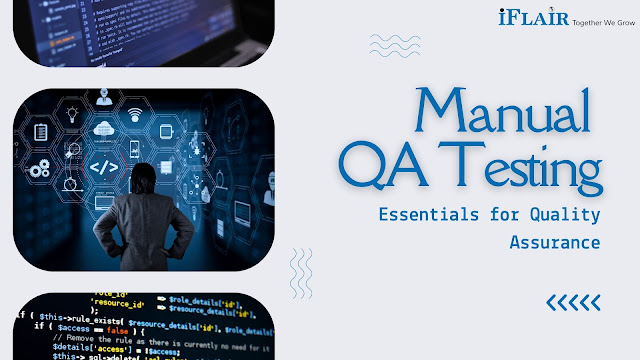Manual QA Testing Essentials for Quality Assurance
In the fast-paced world of software development, quality assurance plays a pivotal role in ensuring that the end product meets the highest standards. Manual QA testing remains an essential component of the quality assurance process, alongside automated testing. In this blog, we'll delve into the core aspects of manual QA testing and discuss the significance of manual testing services, manual QA testing services, and the broader spectrum of QA testing services in the software development industry.
Understanding Manual QA Testing
Manual QA testing, often simply referred to as manual testing, involves human testers executing test cases without the use of automation tools. This hands-on approach allows testers to mimic user interactions with the software to identify defects, inconsistencies, and other issues.
Key Aspects of Manual QA Testing
- Exploratory Testing:
Manual testing allows testers to explore the application intuitively, uncovering defects that automated tests might miss. This approach is particularly valuable for scenarios where requirements are unclear or frequently changing. - Usability Testing:
Testers assess the software's user-friendliness, ensuring that it's intuitive, responsive, and easy to navigate. - Ad-Hoc Testing:
Testers perform unplanned testing, simulating real-world usage scenarios to detect unexpected issues. - Boundary Value Analysis:
Testers assess the application's behavior near its limits, verifying how it handles extreme input values.
Manual QA Testing Services
In the software development industry, manual QA testing services are instrumental in ensuring the quality of the product before it reaches end-users. These services are offered by specialized quality assurance teams that focus on thorough testing to detect and rectify any potential issues.
The Role of Manual QA Testing Services
- Error Detection:Manual testing services help detect critical errors, functional glitches, and design inconsistencies that automated testing might overlook.
- Usability Assessment:These services assess the user experience, identifying areas for improvement and ensuring the software is user-friendly.
- Compatibility Testing:Manual QA testing services also cover compatibility testing across different devices, browsers, and platforms to ensure the application functions seamlessly in various environments.
The Significance of Manual QA Services
- Real User Perspective: Manual testers can provide valuable insights into how real users might interact with the software, helping developers fine-tune the user interface and experience.
- Test Case Creation: Manual QA services involve creating detailed test cases, which can be reused in the future to maintain consistent quality standards.
- Effective Regression Testing: Manual testers can identify regression issues that might arise as the software evolves, ensuring that new updates don't break existing functionalities.
Manual QA Testing vs. Automated Testing
While automated testing can be efficient for repetitive and well-defined test cases, manual QA testing remains irreplaceable in certain scenarios. It's essential to strike a balance between the two approaches.
When to Choose Manual QA Testing:
- Exploratory Testing: When requirements are not well-documented or frequently changing, manual testing is the better choice for exploratory and ad-hoc testing.
- Usability Testing: Manual testing is crucial to evaluate the user interface, user experience, and overall usability of the software.
- Early Stage Testing: In the initial stages of software development, manual testing can help identify critical issues before automation can be implemented effectively.
- Complex Scenarios: When dealing with complex scenarios or multi-step test cases, manual testing is more suitable.
When to Choose Automated Testing:
- Regression Testing: For repetitive regression tests, automated testing is highly efficient and saves time.
- Load Testing: Automated tools are ideal for simulating a large number of users and assessing system performance under load.
- Frequent Repetition: When tests need to be executed frequently, such as with continuous integration, automated testing is the better choice.
Quality Assurance (QA) Testing Services
Quality assurance encompasses a broader spectrum of testing services, including both manual and automated testing. QA testing service aim to maintain the quality and reliability of software products throughout the development lifecycle.
The Role of QA Testing Services
- Comprehensive Testing: QA testing services cover various aspects, including functionality, performance, security, and compatibility.
- Defect Identification: QA testers identify defects at every stage of development, ensuring they are addressed promptly.
- Improvement Feedback: QA teams provide feedback and suggestions to developers for enhancing the software's quality and functionality.
- Risk Mitigation: By rigorously testing the software, QA services reduce the risk of critical issues occurring after the software is released to end-users.
Conclusion
In the realm of software development, manual QA testing services, along with automated testing, are vital for achieving top-notch quality assurance. Manual testing allows for in-depth exploratory and usability testing, while manual QA testing services provide specialized teams to perform comprehensive quality checks.
Balancing manual and automated testing is key to achieving a well-rounded quality assurance process. Automated testing is efficient for repetitive tasks, while manual testing excels in exploring and evaluating software from a real user's perspective.
Ultimately, the combined efforts of manual QA testing, manual QA testing services, and the broader spectrum of QA testing services ensure that software products meet the highest quality standards, providing end-users with a seamless and satisfying experience. Quality assurance remains an indispensable pillar in the software development industry, and manual testing services continue to be an essential part of this foundation.




Comments
Post a Comment